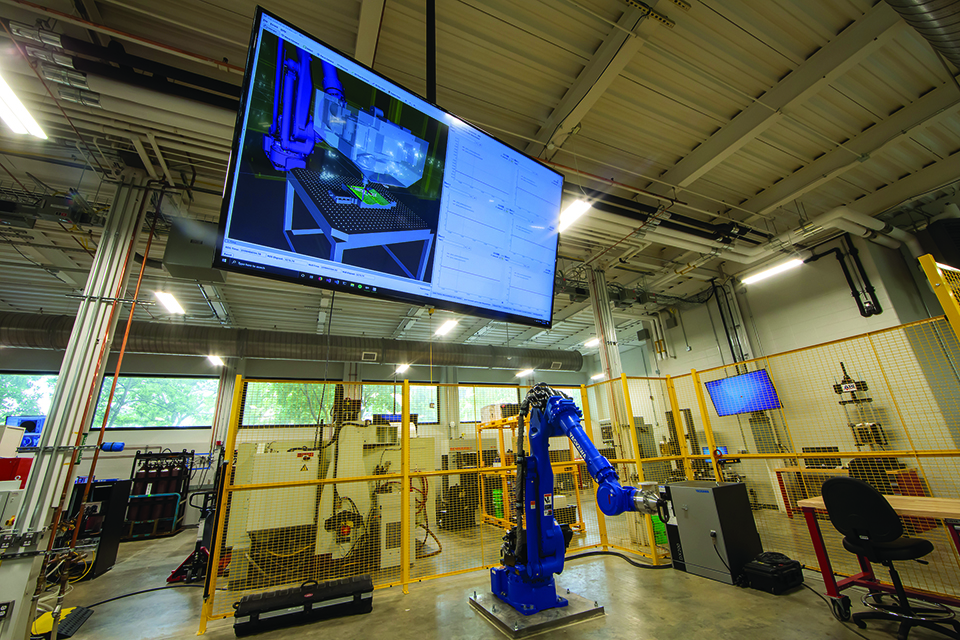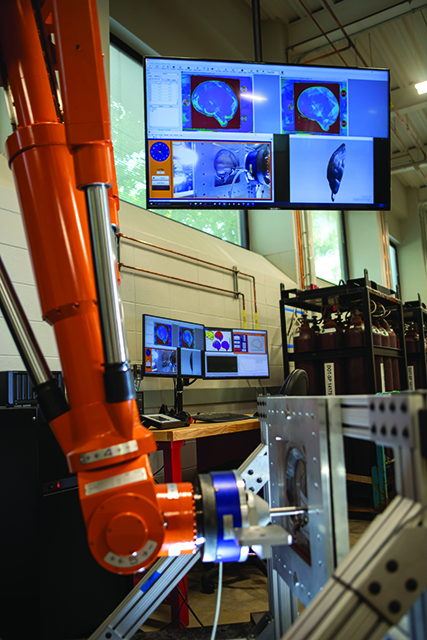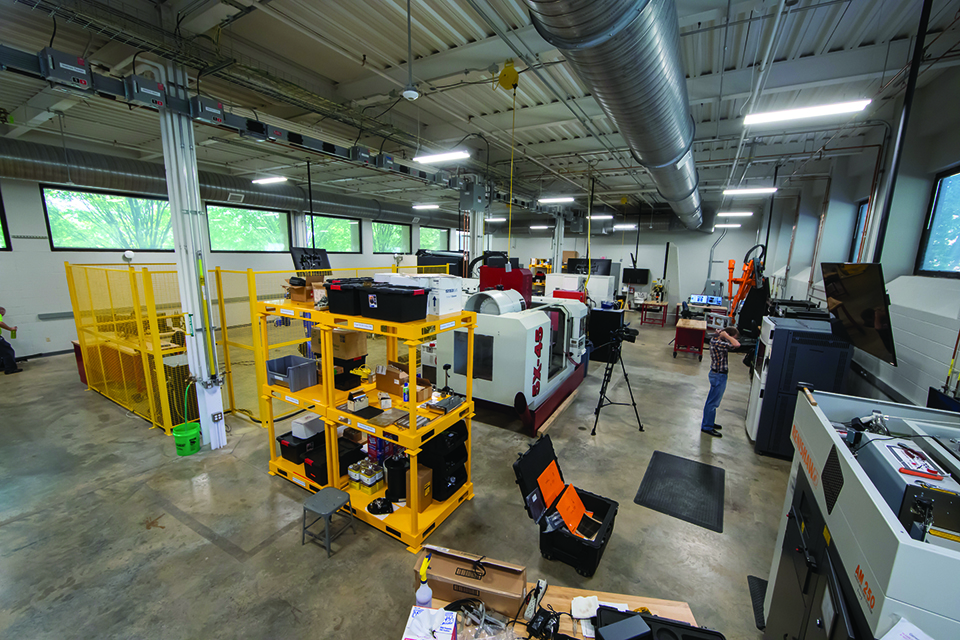CAMT gets production ready
A premier national center for manufacturing research, the Center for Aerospace Manufacturing Technologies (CAMT) at Missouri S&T has seen significant changes and growth over the past few years. Shifting focus from impact through published research to an industrial impact by directly inserting applied research and technologies into manufacturing production in partnership with companies, CAMT is transforming to be a top value-producing resource for all members. A 6,000-square-foot space and $1.4 million was allocated by the College of Engineering and Computing to begin renovation to house CAMT’s pre-production research on industrial manufacturing equipment. This space now houses $5 million in manufacturing equipment assets, including state-of-the-art machines such as the DMG-Mori Lasertec 4300, Renishaw AM250, Stratasys Fortus 400, Optomec LENS LPE), supporting equipment for additive manufacturing pre and post-processing and characterization, its incremental sheet forming robot, and additional machines arriving from industry partners. This facility and growth give industry researchers and engineers the space to work side-by-side with S&T students on industrial equipment.

CAMT was founded in May 2004 in partnership with the Air Force Research Laboratory and Boeing Research and Technology to serve as a U.S. center of excellence for the development and transition of innovative advanced technologies for the aerospace manufacturing supply chain. This effort was made possible through a federal appropriation of $8.8 million and was one of the nation’s largest initiatives to develop new manufacturing methods for the aerospace industry.
CAMT has an array of technologies devoted to advancing manufacturing technologies and supports the research and development efforts of creating knowledge, methodologies, and tools that reduce production cost and lead time while improving quality, reliability, and safety in aerospace manufacturing. CAMT operates on a membership funding model, where each company pays for membership and the membership funds are pooled together to fund research of mutual benefit to the consortium.
Founded by Dr. Ming Leu, Keith and Pat Bailey Distinguished Professor of Mechanical Engineering , CAMT today has grown to become the center point of manufacturing research on campus. Led today by Dr. Doug Bristow, professor of mechanical engineering, CAMT’s industry partners and faculty worked together to chart a course for growth. This growth path started with the mission - ...to serve as a national center of excellence to research, develop, evaluate and demonstrate methodologies and tools for rapid and cost-effective manufacturing of aerospace products and to educate the evolving aerospace manufacturing workforce, resulting in significant technological advancement and economic impact. The team outlined clear objectives to achieve these goals:
• Research, develop, evaluate, demonstrate, and transfer advanced technologies of critical importance to the aerospace defense and commercial manufacturing industries in the United States.
• Create knowledge, methodologies, and tools that can improve affordability, rapidity, quality, productivity, reliability, and safety in aerospace manufacturing.
• Disseminate the knowledge, methodologies, and tools developed by the Center to the aerospace manufacturing industry through direct technology transfer as well as the development of education, training, and outreach activities.
• Serve as a role model of university-industry-government collaborative partnership.

Central to this mission and objectives is the expected result of having direct economic impact to the partner companies investing in CAMT. Traditionally, in universities, this impact has been research papers that companies reference when making technology investment decisions and considering students for employment. CAMT, however, saw the opportunity to take this further and dedicates the largest portion of its research portfolio to applied research in partnership with a member company, thereby enabling the research to be directly inserted into manufacturing production. This paradigm shift allows CAMT to directly impact the success of its partners and produces research that is industrially relevant and students that are industrially ready.
Richard Wlezien, vice provost and dean of the College of Engineering and Computing at Missouri S&T, recognized this shift and saw an opportunity for CAMT to grow the impact across a wider network of industry partners by creating a vehicle for preproduction research. Preproduction research uses production-grade equipment, develops working solution, and transitions that complete production solution to the member company for implementation. While CAMT had demonstrated the capacity to do this type of work, CAMT lacked a facility and the production level equipment necessary to deliver that vision. In 2019-2020, led by the Dean’s Office, Missouri S&T invested in the creation of a $1.4 million production-grade high-bay research facility. Industry recognized the opportunity and immediately invested another $3 million in filling the facility. Industrial grade equipment provided by DMGMori, Kansas City National Security Campus, Yaskawa Robotics, and Applied Precision Inc. were added to the facility taking the space from 50% capacity during construction planning to 125% capacity when the space opened less than a year later. As Dr. Bristow recounts, “We built our vision for CAMT in collaboration with engineering leaders at our industrial partners, so it is exciting to see commitments match the collaborative effort, enabling us to deliver a world class production-ready research facility.”
Announced in October 2020, St. Louis businessman and S&T alumnus Fred Kummer and his wife June donated $300 million to launch the Kummer Institute at Missouri S&T. Their gift is the largest single gift ever to any Missouri university, public or private. The Kummer Institute is envisioned to have direct economic impact on the region through technology innovation and entrepreneurship. To achieve these goals, four centers are planned in areas where Missouri S&T is best positioned to impact the economy. Building on the success of CAMT and the MAE manufacturing program, one of these four keystone centers is the Center for Advanced Manufacturing. This transformational opportunity will enable CAMT and MAE to leverage the Kummer family investment and grow the impact exponentially.
CAMT would like to engage your company in manufacturing research. While CAMT was founded on aerospace manufacturing research, the members span multiple industries. Research ranges from additive manufacturing to materials, robotics, and more with a tiered membership structure that allows companies of various sizes to engage. The MAE department is ready to enable your industry-ready manufacturing research either through CAMT or directly with the department. We look forward to showing you CAMT’s new facility and introducing you to our research the next time you are on campus. For more information on CAMT, please contact camt@mst.edu or visit the
website at https://camt.mst.edu/.

